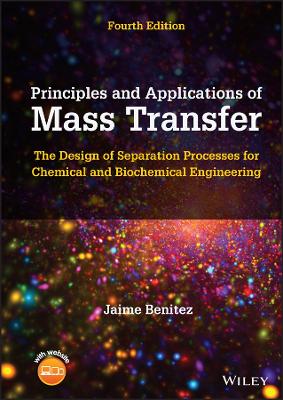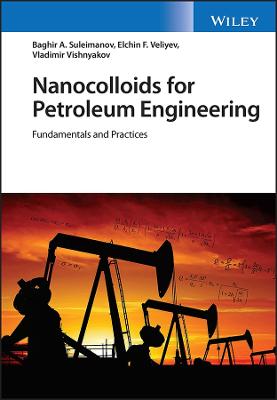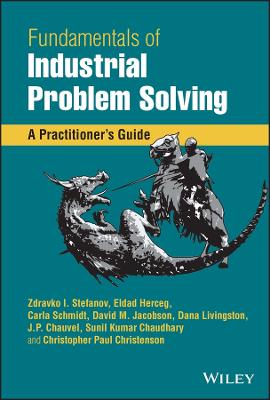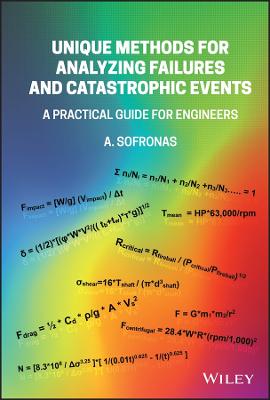Principles and Applications of Mass Transfer
 -15%
portes grátis
-15%
portes grátis
Principles and Applications of Mass Transfer
The Design of Separation Processes for Chemical and Biochemical Engineering
Benitez, Jaime
John Wiley & Sons Inc
10/2022
656
Dura
Inglês
9781119785248
15 a 20 dias
666
Descrição não disponível.
Preface to the Fourth Edition xvii
Preface to the Third Edition xix
Preface to the Second Edition xxi
Preface to the First Edition xxiii
Nomenclature xxv
1. Fundamentals of Mass Transfer 1
1.1 Introduction 1
1.2 Molecular Mass Transfer 3
1.2.1 Concentrations 4
1.2.2 Velocities and Fluxes 10
1.2.3 The Maxwell-Stefan Relations 12
1.2.4 Fick's First Law for Binary Mixtures 15
1.3 The Diffusion Coefficient 16
1.3.1 Diffusion Coefficients for Binary Ideal Gas Systems 17
1.3.2 Diffusion Coefficients for Dilute Liquids 22
1.3.3 Diffusion Coefficients for Concentrated Liquids 26
1.3.4 Effective Diffusivities in Multi component Mixtures 28
1.4 Steady-state Molecular Diffusion in Fluids 34
1.4.1 Molar Flux and the Equation of Continuity 34
1.4.2 Steady-State Molecular Diffusion in Gases 35
1.4.3 Steady-State Molecular Diffusion in Liquids 47
1.5 Steady-state Diffusion in Solids 50
1.5.1Steady-State Binary Molecular Diffusion in Porous Solids 51
1.5.2 Knudsen Diffusion in Porous Solids 52
1.5.3 Hydrodynamic Flow of Gases in Porous Solids 55
1.5.4"DustyGas"Model for Multi component Diffusion 57
1.6 Transient Molecular Diffusion in Solids 58
1.7 Diffusion with Homogeneous Chemical Reaction 62
1.8 Analogies Among Molecular Transfer Phenomena 66
Problems 68
References 83
Appendix 1.1 84
Appendix 1.2 85
Appendix 1.3 86
Appendix 1.4 89
2. Convective Mass Transfer 91
2.1 Introduction 91
2.2 Mass-transfer Coefficients 92
2.2.1 Diffusion of A Through Stagnant B (NB=0,?A=1) 92
2.2.2 Equimolar Counter diffusion (NB=-NA,?A=undefined) 95
2.3 Dimensional Analysis 96
2.3.1 The Buckingham Method 97
2.4 Flow Past Flat Plate in Laminar Flow; Boundary Layer Theory 101
2.5 Mass- and Heat-transfer Analogies 108
2.6 Convective Mass-transfer Correlations 116
2.6.1 Mass-Transfer Coefficients for Flat Plates 116
2.6.2 Mass-Transfer Coefficients for a Single Sphere 118
2.6.3 Mass-Transfer Coefficients for Single Cylinders 122
2.6.4 Turbulent Flow in Circular Pipes 122
2.6.5 Mass Transfer in Packed and Fluidized Beds 128
2.6.6 Mass Transfer in Hollow-Fiber Membrane Modules130
2.7Multi component Mass-transfer Coefficients 133
Problems 135
References 149
Appendix 2.1 152
Appendix 2.2 153
3. Interphase Mass Transfer 155
3.1Introduction 155
3.2 Equilibrium Considerations in Chemical and Biochemical Systems 155
3.2.1 Chemical Phase Equilibria 156
3.2.2 Biochemical Equilibrium Concepts (Seaderetal.,2011) 160
3.3 Diffusion Between Phases 166
3.3.1 Two-Resistance Theory 166
3.3.2 Overall Mass-Transfer Coefficients 168
3.3.3 Local Mass-Transfer Coefficients: General Case 172
3.4 Material Balances 180
3.4.1 Counter current Flow 180
3.4.2 Co current Flow 194
3.4.3 Batch Processes 195
3.5 Equilibrium-stage Operations 196
Problems 204
References 216
Appendix 3.1 217
Appendix 3.2 218
Appendix 3.3 219
Appendix 3.4 220
Appendix 3.5 221
4. Equipment for Gas-liquid Mass-transfer Operations 225
4.1 Introduction 225
4.2 Gas-liquid Operations :Liquid Dispersed 225
4.2.1 Types of Packing 226
4.2.2 Liquid Distribution 229
4.2.3 Liquid Holdup 230
4.2.4 Pressure Drop 237
4.2.5 Mass-Transfer Coefficients 239
4.3 Gas-liquid Operations : Gas Dispersed 243
4.3.1 Sparged Vessels (Bubble Columns) 244
4.3.2 Tray Towers 249
4.3.3 Tray Diameter 252
4.3.4 Tray Gas-Pressure Drop 255
4.3.5 Weeping and Entrainment 257
4.3.6 Tray Efficiency 258
Problems 264
References 274
5. Absorption and Stripping 277
5.1 Introduction 277
5.2 Counter current Multi stage Equipment 278
5.2.1 Graphical Determination of the Number of IdealTrays 278
5.2.2 Tray Efficiencies and Real Traysby Graphical Methods 279
5.2.3 Dilute Mixtures279
5.3 Counter current Continuous-contact Equipment285
5.3.1 Dilute Solutions; Henry's Law290
5.4 Thermal Effects During Absorption and Stripping 292
5.4.1 Adiabatic Operation of a Packed-Bed Absorber 296
Problems 300
References 311
Appendix 5.1 312
6. Distillation 315
6.1Introduction 315
6.2 Single-stage Operation-flash Vaporization 316
6.3 DifferentialDistillation320
6.4ContinuousRectification-binarySystems322
6.5 Mc CABE-Thiele method for trayed towers324
6.5.1 Rectifying Section 325
6.5.2 Stripping Section 326
6.5.3 Feed Stage 328
6.5.4 Number of Equilibrium Stages and Feed-Stage Location 330
6.5.5 Limiting Conditions 332
6.5.6 Optimum Reflux Ratio 333
6.5.7 Large Number of Stages 339
6.5.8 Use of Open Steam 342
6.5.9 Tray Efficiencies 343
6.6 Binary Distillation in Packed Towers350
6.7 Multi component Distillation 354
6.8 Fenske-underwood-Gillil and Method 357
6.8.1 Total Reflux : Fenske Equation 357
6.8.2 Minimum Reflux : Underwood Equations 361
6.8.3 Gillil and Correlation for Number of Stages at Finite Reflux 366
6.9 Rigorous Calculation Procedures for Multi component Distillation 368
6.9.1 Equilibrium Stage Model368
6.9.2 Non equilibrium, Rate-Based Model 370
6.10 Batch Distillation 371
6.10.1 Binary Batch Distillation with Constant Reflux 372
6.10.2 Batch Distillation with Constant Distillate Composition 375
6.10.3 Multicomponent Batch Distillation 377
Problems 378
References 389
Appendix 6.1 390
Appendix 6.2 391
Appendix 6.3 392
7. Liquid-liquid Extraction 393
7.1 Introduction 393
7.2 Liquid Equilibria 394
7.3 Stage wise Liquid-liquid Extraction 399
7.3.1 Single-Stage Extraction 400
7.3.2 Multistage Crosscurrent Extraction 403
7.3.3 Counter current Extraction Cascades4 04
7.3.4 Insoluble Liquids 409
7.3.5 Continuous Countercurrent Extraction with Reflux 412
7.4 Equipment for Liquid-liquid Extraction 419
7.4.1Mixer-Settler Cascades 419
7.4.2 Multi compartment Columns 428
7. Liquid-liquid Extraction of Bio products 430
Problems 437
References 446
8. Humidification Operations447
8.1 Introduction 447
8.2 Equilibrium Considerations 448
8.2.1 Saturated Gas-Vapor Mixtures 448
8.2.2 Unsaturated Gas-Vapor Mixtures 451
8.2.3 Adiabatic-Saturation Curves 452
8.2.4 Wet-Bulb Temperature 454
8.3 Adiabatic Gas-liquid Contact Operations 457
8.3.1 Fundamental Relationships 458
8.3.2 Water Cooling with Air 460
8.3.3 Dehumidification of Air-Water Vapor 466
Problems 468
References 472
Appendix 8.1 473
Appendix 8.2 474
9. Membranes and other Solid: Sorption Agents 477
9.1 Introduction 477
9.2 Mass Transfer in Membranes 478
9.2.1 Solution-Diffusion for Liquid Mixtures479
9.2.2 Solution-Diffusionfor Gas Mixtures 481
9.2.3 Module Flow Patterns 484
9.3 Equilibrium Considerations in Porous Sorbents 489
9.3.1 Adsorption and Chromatography Equilibria 489
9.3.2 Ion-Exchange Equilibria 494
9.4 Mass Transfer in Fixed Beds of Porous Sorbents 497
9.4.1 Basic Equations for Adsorption 499
9.4.2 Linear Isotherm 500
9.4.3 Langmuir Isotherm 501
9.4.4 Length of Unused Bed 505
9.4.5 Mass-Transfer Rates in Ion Exchangers506
9.4.6 Mass-Transfer Rates in Chromatographic Separations507
9.4.7 Electrophoresis 510
9.5 Applications of Membrane-separation Processes512
9.5.1 Dialysis 513
9.5.2 Reverse Osmosis 515
9.5.3 Gas Permeation 518
9.5.4 Ultrafiltration and Microfiltration 518
9.5.5 Bio separations 522
9.6 Applications of Sorption-separation Processes524
Problems 529
References 535
Appendix9.1 536
Appendix 9.2 538
Appendix 9.3 540
Appendix 9.4 542
Appendix 9.5 544
Appendix 9.6 546
Appendix 9.7 548
Appendix A Binary Diffusion Coefficients 551
Appendix B Lennard-Jones Constants 555
Appendix C-1 Maxwell-Stefan Equations (Mathcad) 557
Appendix C-2 Maxwell-Stefan Equations (Python) 559
Appendix D-1 Packed-Column Design (Mathcad) 563
Appendix D-2 Packed-Column Design (Python) 569
Appendix E-1 Sieve-Tray Design (Mathcad) 573
Appendix E-2 Sieve-Tray Design (Python) 579
Appendix F-1 McCabe-Thiele Method : Saturated Liquid Feed(Mathcad) 583
Appendix F-2 McCabe-Thiele Method : SaturatedLiquid Feed(Python) 587
Appendix G-1 Single-Stage Extraction (Mathcad) 591
Appendix G-2 Single-Stage Extraction (Python) 593
Appendix G-3 Multi stage Crosscurrent Extraction (Mathcad) 595
Appendix G-4 Multi stage Crosscurrent Extraction (Python) 598
Appendix H Constants and Unit Conversions 601
Index 603
Preface to the Third Edition xix
Preface to the Second Edition xxi
Preface to the First Edition xxiii
Nomenclature xxv
1. Fundamentals of Mass Transfer 1
1.1 Introduction 1
1.2 Molecular Mass Transfer 3
1.2.1 Concentrations 4
1.2.2 Velocities and Fluxes 10
1.2.3 The Maxwell-Stefan Relations 12
1.2.4 Fick's First Law for Binary Mixtures 15
1.3 The Diffusion Coefficient 16
1.3.1 Diffusion Coefficients for Binary Ideal Gas Systems 17
1.3.2 Diffusion Coefficients for Dilute Liquids 22
1.3.3 Diffusion Coefficients for Concentrated Liquids 26
1.3.4 Effective Diffusivities in Multi component Mixtures 28
1.4 Steady-state Molecular Diffusion in Fluids 34
1.4.1 Molar Flux and the Equation of Continuity 34
1.4.2 Steady-State Molecular Diffusion in Gases 35
1.4.3 Steady-State Molecular Diffusion in Liquids 47
1.5 Steady-state Diffusion in Solids 50
1.5.1Steady-State Binary Molecular Diffusion in Porous Solids 51
1.5.2 Knudsen Diffusion in Porous Solids 52
1.5.3 Hydrodynamic Flow of Gases in Porous Solids 55
1.5.4"DustyGas"Model for Multi component Diffusion 57
1.6 Transient Molecular Diffusion in Solids 58
1.7 Diffusion with Homogeneous Chemical Reaction 62
1.8 Analogies Among Molecular Transfer Phenomena 66
Problems 68
References 83
Appendix 1.1 84
Appendix 1.2 85
Appendix 1.3 86
Appendix 1.4 89
2. Convective Mass Transfer 91
2.1 Introduction 91
2.2 Mass-transfer Coefficients 92
2.2.1 Diffusion of A Through Stagnant B (NB=0,?A=1) 92
2.2.2 Equimolar Counter diffusion (NB=-NA,?A=undefined) 95
2.3 Dimensional Analysis 96
2.3.1 The Buckingham Method 97
2.4 Flow Past Flat Plate in Laminar Flow; Boundary Layer Theory 101
2.5 Mass- and Heat-transfer Analogies 108
2.6 Convective Mass-transfer Correlations 116
2.6.1 Mass-Transfer Coefficients for Flat Plates 116
2.6.2 Mass-Transfer Coefficients for a Single Sphere 118
2.6.3 Mass-Transfer Coefficients for Single Cylinders 122
2.6.4 Turbulent Flow in Circular Pipes 122
2.6.5 Mass Transfer in Packed and Fluidized Beds 128
2.6.6 Mass Transfer in Hollow-Fiber Membrane Modules130
2.7Multi component Mass-transfer Coefficients 133
Problems 135
References 149
Appendix 2.1 152
Appendix 2.2 153
3. Interphase Mass Transfer 155
3.1Introduction 155
3.2 Equilibrium Considerations in Chemical and Biochemical Systems 155
3.2.1 Chemical Phase Equilibria 156
3.2.2 Biochemical Equilibrium Concepts (Seaderetal.,2011) 160
3.3 Diffusion Between Phases 166
3.3.1 Two-Resistance Theory 166
3.3.2 Overall Mass-Transfer Coefficients 168
3.3.3 Local Mass-Transfer Coefficients: General Case 172
3.4 Material Balances 180
3.4.1 Counter current Flow 180
3.4.2 Co current Flow 194
3.4.3 Batch Processes 195
3.5 Equilibrium-stage Operations 196
Problems 204
References 216
Appendix 3.1 217
Appendix 3.2 218
Appendix 3.3 219
Appendix 3.4 220
Appendix 3.5 221
4. Equipment for Gas-liquid Mass-transfer Operations 225
4.1 Introduction 225
4.2 Gas-liquid Operations :Liquid Dispersed 225
4.2.1 Types of Packing 226
4.2.2 Liquid Distribution 229
4.2.3 Liquid Holdup 230
4.2.4 Pressure Drop 237
4.2.5 Mass-Transfer Coefficients 239
4.3 Gas-liquid Operations : Gas Dispersed 243
4.3.1 Sparged Vessels (Bubble Columns) 244
4.3.2 Tray Towers 249
4.3.3 Tray Diameter 252
4.3.4 Tray Gas-Pressure Drop 255
4.3.5 Weeping and Entrainment 257
4.3.6 Tray Efficiency 258
Problems 264
References 274
5. Absorption and Stripping 277
5.1 Introduction 277
5.2 Counter current Multi stage Equipment 278
5.2.1 Graphical Determination of the Number of IdealTrays 278
5.2.2 Tray Efficiencies and Real Traysby Graphical Methods 279
5.2.3 Dilute Mixtures279
5.3 Counter current Continuous-contact Equipment285
5.3.1 Dilute Solutions; Henry's Law290
5.4 Thermal Effects During Absorption and Stripping 292
5.4.1 Adiabatic Operation of a Packed-Bed Absorber 296
Problems 300
References 311
Appendix 5.1 312
6. Distillation 315
6.1Introduction 315
6.2 Single-stage Operation-flash Vaporization 316
6.3 DifferentialDistillation320
6.4ContinuousRectification-binarySystems322
6.5 Mc CABE-Thiele method for trayed towers324
6.5.1 Rectifying Section 325
6.5.2 Stripping Section 326
6.5.3 Feed Stage 328
6.5.4 Number of Equilibrium Stages and Feed-Stage Location 330
6.5.5 Limiting Conditions 332
6.5.6 Optimum Reflux Ratio 333
6.5.7 Large Number of Stages 339
6.5.8 Use of Open Steam 342
6.5.9 Tray Efficiencies 343
6.6 Binary Distillation in Packed Towers350
6.7 Multi component Distillation 354
6.8 Fenske-underwood-Gillil and Method 357
6.8.1 Total Reflux : Fenske Equation 357
6.8.2 Minimum Reflux : Underwood Equations 361
6.8.3 Gillil and Correlation for Number of Stages at Finite Reflux 366
6.9 Rigorous Calculation Procedures for Multi component Distillation 368
6.9.1 Equilibrium Stage Model368
6.9.2 Non equilibrium, Rate-Based Model 370
6.10 Batch Distillation 371
6.10.1 Binary Batch Distillation with Constant Reflux 372
6.10.2 Batch Distillation with Constant Distillate Composition 375
6.10.3 Multicomponent Batch Distillation 377
Problems 378
References 389
Appendix 6.1 390
Appendix 6.2 391
Appendix 6.3 392
7. Liquid-liquid Extraction 393
7.1 Introduction 393
7.2 Liquid Equilibria 394
7.3 Stage wise Liquid-liquid Extraction 399
7.3.1 Single-Stage Extraction 400
7.3.2 Multistage Crosscurrent Extraction 403
7.3.3 Counter current Extraction Cascades4 04
7.3.4 Insoluble Liquids 409
7.3.5 Continuous Countercurrent Extraction with Reflux 412
7.4 Equipment for Liquid-liquid Extraction 419
7.4.1Mixer-Settler Cascades 419
7.4.2 Multi compartment Columns 428
7. Liquid-liquid Extraction of Bio products 430
Problems 437
References 446
8. Humidification Operations447
8.1 Introduction 447
8.2 Equilibrium Considerations 448
8.2.1 Saturated Gas-Vapor Mixtures 448
8.2.2 Unsaturated Gas-Vapor Mixtures 451
8.2.3 Adiabatic-Saturation Curves 452
8.2.4 Wet-Bulb Temperature 454
8.3 Adiabatic Gas-liquid Contact Operations 457
8.3.1 Fundamental Relationships 458
8.3.2 Water Cooling with Air 460
8.3.3 Dehumidification of Air-Water Vapor 466
Problems 468
References 472
Appendix 8.1 473
Appendix 8.2 474
9. Membranes and other Solid: Sorption Agents 477
9.1 Introduction 477
9.2 Mass Transfer in Membranes 478
9.2.1 Solution-Diffusion for Liquid Mixtures479
9.2.2 Solution-Diffusionfor Gas Mixtures 481
9.2.3 Module Flow Patterns 484
9.3 Equilibrium Considerations in Porous Sorbents 489
9.3.1 Adsorption and Chromatography Equilibria 489
9.3.2 Ion-Exchange Equilibria 494
9.4 Mass Transfer in Fixed Beds of Porous Sorbents 497
9.4.1 Basic Equations for Adsorption 499
9.4.2 Linear Isotherm 500
9.4.3 Langmuir Isotherm 501
9.4.4 Length of Unused Bed 505
9.4.5 Mass-Transfer Rates in Ion Exchangers506
9.4.6 Mass-Transfer Rates in Chromatographic Separations507
9.4.7 Electrophoresis 510
9.5 Applications of Membrane-separation Processes512
9.5.1 Dialysis 513
9.5.2 Reverse Osmosis 515
9.5.3 Gas Permeation 518
9.5.4 Ultrafiltration and Microfiltration 518
9.5.5 Bio separations 522
9.6 Applications of Sorption-separation Processes524
Problems 529
References 535
Appendix9.1 536
Appendix 9.2 538
Appendix 9.3 540
Appendix 9.4 542
Appendix 9.5 544
Appendix 9.6 546
Appendix 9.7 548
Appendix A Binary Diffusion Coefficients 551
Appendix B Lennard-Jones Constants 555
Appendix C-1 Maxwell-Stefan Equations (Mathcad) 557
Appendix C-2 Maxwell-Stefan Equations (Python) 559
Appendix D-1 Packed-Column Design (Mathcad) 563
Appendix D-2 Packed-Column Design (Python) 569
Appendix E-1 Sieve-Tray Design (Mathcad) 573
Appendix E-2 Sieve-Tray Design (Python) 579
Appendix F-1 McCabe-Thiele Method : Saturated Liquid Feed(Mathcad) 583
Appendix F-2 McCabe-Thiele Method : SaturatedLiquid Feed(Python) 587
Appendix G-1 Single-Stage Extraction (Mathcad) 591
Appendix G-2 Single-Stage Extraction (Python) 593
Appendix G-3 Multi stage Crosscurrent Extraction (Mathcad) 595
Appendix G-4 Multi stage Crosscurrent Extraction (Python) 598
Appendix H Constants and Unit Conversions 601
Index 603
Este título pertence ao(s) assunto(s) indicados(s). Para ver outros títulos clique no assunto desejado.
mass transfer fundamentals; mass transfer textbook; design of separation processes; MathCad; Python; separation process equipment; transient diffusion; mass transfer environmental applications; electrophoresis; bioseparations; membranes
Preface to the Fourth Edition xvii
Preface to the Third Edition xix
Preface to the Second Edition xxi
Preface to the First Edition xxiii
Nomenclature xxv
1. Fundamentals of Mass Transfer 1
1.1 Introduction 1
1.2 Molecular Mass Transfer 3
1.2.1 Concentrations 4
1.2.2 Velocities and Fluxes 10
1.2.3 The Maxwell-Stefan Relations 12
1.2.4 Fick's First Law for Binary Mixtures 15
1.3 The Diffusion Coefficient 16
1.3.1 Diffusion Coefficients for Binary Ideal Gas Systems 17
1.3.2 Diffusion Coefficients for Dilute Liquids 22
1.3.3 Diffusion Coefficients for Concentrated Liquids 26
1.3.4 Effective Diffusivities in Multi component Mixtures 28
1.4 Steady-state Molecular Diffusion in Fluids 34
1.4.1 Molar Flux and the Equation of Continuity 34
1.4.2 Steady-State Molecular Diffusion in Gases 35
1.4.3 Steady-State Molecular Diffusion in Liquids 47
1.5 Steady-state Diffusion in Solids 50
1.5.1Steady-State Binary Molecular Diffusion in Porous Solids 51
1.5.2 Knudsen Diffusion in Porous Solids 52
1.5.3 Hydrodynamic Flow of Gases in Porous Solids 55
1.5.4"DustyGas"Model for Multi component Diffusion 57
1.6 Transient Molecular Diffusion in Solids 58
1.7 Diffusion with Homogeneous Chemical Reaction 62
1.8 Analogies Among Molecular Transfer Phenomena 66
Problems 68
References 83
Appendix 1.1 84
Appendix 1.2 85
Appendix 1.3 86
Appendix 1.4 89
2. Convective Mass Transfer 91
2.1 Introduction 91
2.2 Mass-transfer Coefficients 92
2.2.1 Diffusion of A Through Stagnant B (NB=0,?A=1) 92
2.2.2 Equimolar Counter diffusion (NB=-NA,?A=undefined) 95
2.3 Dimensional Analysis 96
2.3.1 The Buckingham Method 97
2.4 Flow Past Flat Plate in Laminar Flow; Boundary Layer Theory 101
2.5 Mass- and Heat-transfer Analogies 108
2.6 Convective Mass-transfer Correlations 116
2.6.1 Mass-Transfer Coefficients for Flat Plates 116
2.6.2 Mass-Transfer Coefficients for a Single Sphere 118
2.6.3 Mass-Transfer Coefficients for Single Cylinders 122
2.6.4 Turbulent Flow in Circular Pipes 122
2.6.5 Mass Transfer in Packed and Fluidized Beds 128
2.6.6 Mass Transfer in Hollow-Fiber Membrane Modules130
2.7Multi component Mass-transfer Coefficients 133
Problems 135
References 149
Appendix 2.1 152
Appendix 2.2 153
3. Interphase Mass Transfer 155
3.1Introduction 155
3.2 Equilibrium Considerations in Chemical and Biochemical Systems 155
3.2.1 Chemical Phase Equilibria 156
3.2.2 Biochemical Equilibrium Concepts (Seaderetal.,2011) 160
3.3 Diffusion Between Phases 166
3.3.1 Two-Resistance Theory 166
3.3.2 Overall Mass-Transfer Coefficients 168
3.3.3 Local Mass-Transfer Coefficients: General Case 172
3.4 Material Balances 180
3.4.1 Counter current Flow 180
3.4.2 Co current Flow 194
3.4.3 Batch Processes 195
3.5 Equilibrium-stage Operations 196
Problems 204
References 216
Appendix 3.1 217
Appendix 3.2 218
Appendix 3.3 219
Appendix 3.4 220
Appendix 3.5 221
4. Equipment for Gas-liquid Mass-transfer Operations 225
4.1 Introduction 225
4.2 Gas-liquid Operations :Liquid Dispersed 225
4.2.1 Types of Packing 226
4.2.2 Liquid Distribution 229
4.2.3 Liquid Holdup 230
4.2.4 Pressure Drop 237
4.2.5 Mass-Transfer Coefficients 239
4.3 Gas-liquid Operations : Gas Dispersed 243
4.3.1 Sparged Vessels (Bubble Columns) 244
4.3.2 Tray Towers 249
4.3.3 Tray Diameter 252
4.3.4 Tray Gas-Pressure Drop 255
4.3.5 Weeping and Entrainment 257
4.3.6 Tray Efficiency 258
Problems 264
References 274
5. Absorption and Stripping 277
5.1 Introduction 277
5.2 Counter current Multi stage Equipment 278
5.2.1 Graphical Determination of the Number of IdealTrays 278
5.2.2 Tray Efficiencies and Real Traysby Graphical Methods 279
5.2.3 Dilute Mixtures279
5.3 Counter current Continuous-contact Equipment285
5.3.1 Dilute Solutions; Henry's Law290
5.4 Thermal Effects During Absorption and Stripping 292
5.4.1 Adiabatic Operation of a Packed-Bed Absorber 296
Problems 300
References 311
Appendix 5.1 312
6. Distillation 315
6.1Introduction 315
6.2 Single-stage Operation-flash Vaporization 316
6.3 DifferentialDistillation320
6.4ContinuousRectification-binarySystems322
6.5 Mc CABE-Thiele method for trayed towers324
6.5.1 Rectifying Section 325
6.5.2 Stripping Section 326
6.5.3 Feed Stage 328
6.5.4 Number of Equilibrium Stages and Feed-Stage Location 330
6.5.5 Limiting Conditions 332
6.5.6 Optimum Reflux Ratio 333
6.5.7 Large Number of Stages 339
6.5.8 Use of Open Steam 342
6.5.9 Tray Efficiencies 343
6.6 Binary Distillation in Packed Towers350
6.7 Multi component Distillation 354
6.8 Fenske-underwood-Gillil and Method 357
6.8.1 Total Reflux : Fenske Equation 357
6.8.2 Minimum Reflux : Underwood Equations 361
6.8.3 Gillil and Correlation for Number of Stages at Finite Reflux 366
6.9 Rigorous Calculation Procedures for Multi component Distillation 368
6.9.1 Equilibrium Stage Model368
6.9.2 Non equilibrium, Rate-Based Model 370
6.10 Batch Distillation 371
6.10.1 Binary Batch Distillation with Constant Reflux 372
6.10.2 Batch Distillation with Constant Distillate Composition 375
6.10.3 Multicomponent Batch Distillation 377
Problems 378
References 389
Appendix 6.1 390
Appendix 6.2 391
Appendix 6.3 392
7. Liquid-liquid Extraction 393
7.1 Introduction 393
7.2 Liquid Equilibria 394
7.3 Stage wise Liquid-liquid Extraction 399
7.3.1 Single-Stage Extraction 400
7.3.2 Multistage Crosscurrent Extraction 403
7.3.3 Counter current Extraction Cascades4 04
7.3.4 Insoluble Liquids 409
7.3.5 Continuous Countercurrent Extraction with Reflux 412
7.4 Equipment for Liquid-liquid Extraction 419
7.4.1Mixer-Settler Cascades 419
7.4.2 Multi compartment Columns 428
7. Liquid-liquid Extraction of Bio products 430
Problems 437
References 446
8. Humidification Operations447
8.1 Introduction 447
8.2 Equilibrium Considerations 448
8.2.1 Saturated Gas-Vapor Mixtures 448
8.2.2 Unsaturated Gas-Vapor Mixtures 451
8.2.3 Adiabatic-Saturation Curves 452
8.2.4 Wet-Bulb Temperature 454
8.3 Adiabatic Gas-liquid Contact Operations 457
8.3.1 Fundamental Relationships 458
8.3.2 Water Cooling with Air 460
8.3.3 Dehumidification of Air-Water Vapor 466
Problems 468
References 472
Appendix 8.1 473
Appendix 8.2 474
9. Membranes and other Solid: Sorption Agents 477
9.1 Introduction 477
9.2 Mass Transfer in Membranes 478
9.2.1 Solution-Diffusion for Liquid Mixtures479
9.2.2 Solution-Diffusionfor Gas Mixtures 481
9.2.3 Module Flow Patterns 484
9.3 Equilibrium Considerations in Porous Sorbents 489
9.3.1 Adsorption and Chromatography Equilibria 489
9.3.2 Ion-Exchange Equilibria 494
9.4 Mass Transfer in Fixed Beds of Porous Sorbents 497
9.4.1 Basic Equations for Adsorption 499
9.4.2 Linear Isotherm 500
9.4.3 Langmuir Isotherm 501
9.4.4 Length of Unused Bed 505
9.4.5 Mass-Transfer Rates in Ion Exchangers506
9.4.6 Mass-Transfer Rates in Chromatographic Separations507
9.4.7 Electrophoresis 510
9.5 Applications of Membrane-separation Processes512
9.5.1 Dialysis 513
9.5.2 Reverse Osmosis 515
9.5.3 Gas Permeation 518
9.5.4 Ultrafiltration and Microfiltration 518
9.5.5 Bio separations 522
9.6 Applications of Sorption-separation Processes524
Problems 529
References 535
Appendix9.1 536
Appendix 9.2 538
Appendix 9.3 540
Appendix 9.4 542
Appendix 9.5 544
Appendix 9.6 546
Appendix 9.7 548
Appendix A Binary Diffusion Coefficients 551
Appendix B Lennard-Jones Constants 555
Appendix C-1 Maxwell-Stefan Equations (Mathcad) 557
Appendix C-2 Maxwell-Stefan Equations (Python) 559
Appendix D-1 Packed-Column Design (Mathcad) 563
Appendix D-2 Packed-Column Design (Python) 569
Appendix E-1 Sieve-Tray Design (Mathcad) 573
Appendix E-2 Sieve-Tray Design (Python) 579
Appendix F-1 McCabe-Thiele Method : Saturated Liquid Feed(Mathcad) 583
Appendix F-2 McCabe-Thiele Method : SaturatedLiquid Feed(Python) 587
Appendix G-1 Single-Stage Extraction (Mathcad) 591
Appendix G-2 Single-Stage Extraction (Python) 593
Appendix G-3 Multi stage Crosscurrent Extraction (Mathcad) 595
Appendix G-4 Multi stage Crosscurrent Extraction (Python) 598
Appendix H Constants and Unit Conversions 601
Index 603
Preface to the Third Edition xix
Preface to the Second Edition xxi
Preface to the First Edition xxiii
Nomenclature xxv
1. Fundamentals of Mass Transfer 1
1.1 Introduction 1
1.2 Molecular Mass Transfer 3
1.2.1 Concentrations 4
1.2.2 Velocities and Fluxes 10
1.2.3 The Maxwell-Stefan Relations 12
1.2.4 Fick's First Law for Binary Mixtures 15
1.3 The Diffusion Coefficient 16
1.3.1 Diffusion Coefficients for Binary Ideal Gas Systems 17
1.3.2 Diffusion Coefficients for Dilute Liquids 22
1.3.3 Diffusion Coefficients for Concentrated Liquids 26
1.3.4 Effective Diffusivities in Multi component Mixtures 28
1.4 Steady-state Molecular Diffusion in Fluids 34
1.4.1 Molar Flux and the Equation of Continuity 34
1.4.2 Steady-State Molecular Diffusion in Gases 35
1.4.3 Steady-State Molecular Diffusion in Liquids 47
1.5 Steady-state Diffusion in Solids 50
1.5.1Steady-State Binary Molecular Diffusion in Porous Solids 51
1.5.2 Knudsen Diffusion in Porous Solids 52
1.5.3 Hydrodynamic Flow of Gases in Porous Solids 55
1.5.4"DustyGas"Model for Multi component Diffusion 57
1.6 Transient Molecular Diffusion in Solids 58
1.7 Diffusion with Homogeneous Chemical Reaction 62
1.8 Analogies Among Molecular Transfer Phenomena 66
Problems 68
References 83
Appendix 1.1 84
Appendix 1.2 85
Appendix 1.3 86
Appendix 1.4 89
2. Convective Mass Transfer 91
2.1 Introduction 91
2.2 Mass-transfer Coefficients 92
2.2.1 Diffusion of A Through Stagnant B (NB=0,?A=1) 92
2.2.2 Equimolar Counter diffusion (NB=-NA,?A=undefined) 95
2.3 Dimensional Analysis 96
2.3.1 The Buckingham Method 97
2.4 Flow Past Flat Plate in Laminar Flow; Boundary Layer Theory 101
2.5 Mass- and Heat-transfer Analogies 108
2.6 Convective Mass-transfer Correlations 116
2.6.1 Mass-Transfer Coefficients for Flat Plates 116
2.6.2 Mass-Transfer Coefficients for a Single Sphere 118
2.6.3 Mass-Transfer Coefficients for Single Cylinders 122
2.6.4 Turbulent Flow in Circular Pipes 122
2.6.5 Mass Transfer in Packed and Fluidized Beds 128
2.6.6 Mass Transfer in Hollow-Fiber Membrane Modules130
2.7Multi component Mass-transfer Coefficients 133
Problems 135
References 149
Appendix 2.1 152
Appendix 2.2 153
3. Interphase Mass Transfer 155
3.1Introduction 155
3.2 Equilibrium Considerations in Chemical and Biochemical Systems 155
3.2.1 Chemical Phase Equilibria 156
3.2.2 Biochemical Equilibrium Concepts (Seaderetal.,2011) 160
3.3 Diffusion Between Phases 166
3.3.1 Two-Resistance Theory 166
3.3.2 Overall Mass-Transfer Coefficients 168
3.3.3 Local Mass-Transfer Coefficients: General Case 172
3.4 Material Balances 180
3.4.1 Counter current Flow 180
3.4.2 Co current Flow 194
3.4.3 Batch Processes 195
3.5 Equilibrium-stage Operations 196
Problems 204
References 216
Appendix 3.1 217
Appendix 3.2 218
Appendix 3.3 219
Appendix 3.4 220
Appendix 3.5 221
4. Equipment for Gas-liquid Mass-transfer Operations 225
4.1 Introduction 225
4.2 Gas-liquid Operations :Liquid Dispersed 225
4.2.1 Types of Packing 226
4.2.2 Liquid Distribution 229
4.2.3 Liquid Holdup 230
4.2.4 Pressure Drop 237
4.2.5 Mass-Transfer Coefficients 239
4.3 Gas-liquid Operations : Gas Dispersed 243
4.3.1 Sparged Vessels (Bubble Columns) 244
4.3.2 Tray Towers 249
4.3.3 Tray Diameter 252
4.3.4 Tray Gas-Pressure Drop 255
4.3.5 Weeping and Entrainment 257
4.3.6 Tray Efficiency 258
Problems 264
References 274
5. Absorption and Stripping 277
5.1 Introduction 277
5.2 Counter current Multi stage Equipment 278
5.2.1 Graphical Determination of the Number of IdealTrays 278
5.2.2 Tray Efficiencies and Real Traysby Graphical Methods 279
5.2.3 Dilute Mixtures279
5.3 Counter current Continuous-contact Equipment285
5.3.1 Dilute Solutions; Henry's Law290
5.4 Thermal Effects During Absorption and Stripping 292
5.4.1 Adiabatic Operation of a Packed-Bed Absorber 296
Problems 300
References 311
Appendix 5.1 312
6. Distillation 315
6.1Introduction 315
6.2 Single-stage Operation-flash Vaporization 316
6.3 DifferentialDistillation320
6.4ContinuousRectification-binarySystems322
6.5 Mc CABE-Thiele method for trayed towers324
6.5.1 Rectifying Section 325
6.5.2 Stripping Section 326
6.5.3 Feed Stage 328
6.5.4 Number of Equilibrium Stages and Feed-Stage Location 330
6.5.5 Limiting Conditions 332
6.5.6 Optimum Reflux Ratio 333
6.5.7 Large Number of Stages 339
6.5.8 Use of Open Steam 342
6.5.9 Tray Efficiencies 343
6.6 Binary Distillation in Packed Towers350
6.7 Multi component Distillation 354
6.8 Fenske-underwood-Gillil and Method 357
6.8.1 Total Reflux : Fenske Equation 357
6.8.2 Minimum Reflux : Underwood Equations 361
6.8.3 Gillil and Correlation for Number of Stages at Finite Reflux 366
6.9 Rigorous Calculation Procedures for Multi component Distillation 368
6.9.1 Equilibrium Stage Model368
6.9.2 Non equilibrium, Rate-Based Model 370
6.10 Batch Distillation 371
6.10.1 Binary Batch Distillation with Constant Reflux 372
6.10.2 Batch Distillation with Constant Distillate Composition 375
6.10.3 Multicomponent Batch Distillation 377
Problems 378
References 389
Appendix 6.1 390
Appendix 6.2 391
Appendix 6.3 392
7. Liquid-liquid Extraction 393
7.1 Introduction 393
7.2 Liquid Equilibria 394
7.3 Stage wise Liquid-liquid Extraction 399
7.3.1 Single-Stage Extraction 400
7.3.2 Multistage Crosscurrent Extraction 403
7.3.3 Counter current Extraction Cascades4 04
7.3.4 Insoluble Liquids 409
7.3.5 Continuous Countercurrent Extraction with Reflux 412
7.4 Equipment for Liquid-liquid Extraction 419
7.4.1Mixer-Settler Cascades 419
7.4.2 Multi compartment Columns 428
7. Liquid-liquid Extraction of Bio products 430
Problems 437
References 446
8. Humidification Operations447
8.1 Introduction 447
8.2 Equilibrium Considerations 448
8.2.1 Saturated Gas-Vapor Mixtures 448
8.2.2 Unsaturated Gas-Vapor Mixtures 451
8.2.3 Adiabatic-Saturation Curves 452
8.2.4 Wet-Bulb Temperature 454
8.3 Adiabatic Gas-liquid Contact Operations 457
8.3.1 Fundamental Relationships 458
8.3.2 Water Cooling with Air 460
8.3.3 Dehumidification of Air-Water Vapor 466
Problems 468
References 472
Appendix 8.1 473
Appendix 8.2 474
9. Membranes and other Solid: Sorption Agents 477
9.1 Introduction 477
9.2 Mass Transfer in Membranes 478
9.2.1 Solution-Diffusion for Liquid Mixtures479
9.2.2 Solution-Diffusionfor Gas Mixtures 481
9.2.3 Module Flow Patterns 484
9.3 Equilibrium Considerations in Porous Sorbents 489
9.3.1 Adsorption and Chromatography Equilibria 489
9.3.2 Ion-Exchange Equilibria 494
9.4 Mass Transfer in Fixed Beds of Porous Sorbents 497
9.4.1 Basic Equations for Adsorption 499
9.4.2 Linear Isotherm 500
9.4.3 Langmuir Isotherm 501
9.4.4 Length of Unused Bed 505
9.4.5 Mass-Transfer Rates in Ion Exchangers506
9.4.6 Mass-Transfer Rates in Chromatographic Separations507
9.4.7 Electrophoresis 510
9.5 Applications of Membrane-separation Processes512
9.5.1 Dialysis 513
9.5.2 Reverse Osmosis 515
9.5.3 Gas Permeation 518
9.5.4 Ultrafiltration and Microfiltration 518
9.5.5 Bio separations 522
9.6 Applications of Sorption-separation Processes524
Problems 529
References 535
Appendix9.1 536
Appendix 9.2 538
Appendix 9.3 540
Appendix 9.4 542
Appendix 9.5 544
Appendix 9.6 546
Appendix 9.7 548
Appendix A Binary Diffusion Coefficients 551
Appendix B Lennard-Jones Constants 555
Appendix C-1 Maxwell-Stefan Equations (Mathcad) 557
Appendix C-2 Maxwell-Stefan Equations (Python) 559
Appendix D-1 Packed-Column Design (Mathcad) 563
Appendix D-2 Packed-Column Design (Python) 569
Appendix E-1 Sieve-Tray Design (Mathcad) 573
Appendix E-2 Sieve-Tray Design (Python) 579
Appendix F-1 McCabe-Thiele Method : Saturated Liquid Feed(Mathcad) 583
Appendix F-2 McCabe-Thiele Method : SaturatedLiquid Feed(Python) 587
Appendix G-1 Single-Stage Extraction (Mathcad) 591
Appendix G-2 Single-Stage Extraction (Python) 593
Appendix G-3 Multi stage Crosscurrent Extraction (Mathcad) 595
Appendix G-4 Multi stage Crosscurrent Extraction (Python) 598
Appendix H Constants and Unit Conversions 601
Index 603
Este título pertence ao(s) assunto(s) indicados(s). Para ver outros títulos clique no assunto desejado.







